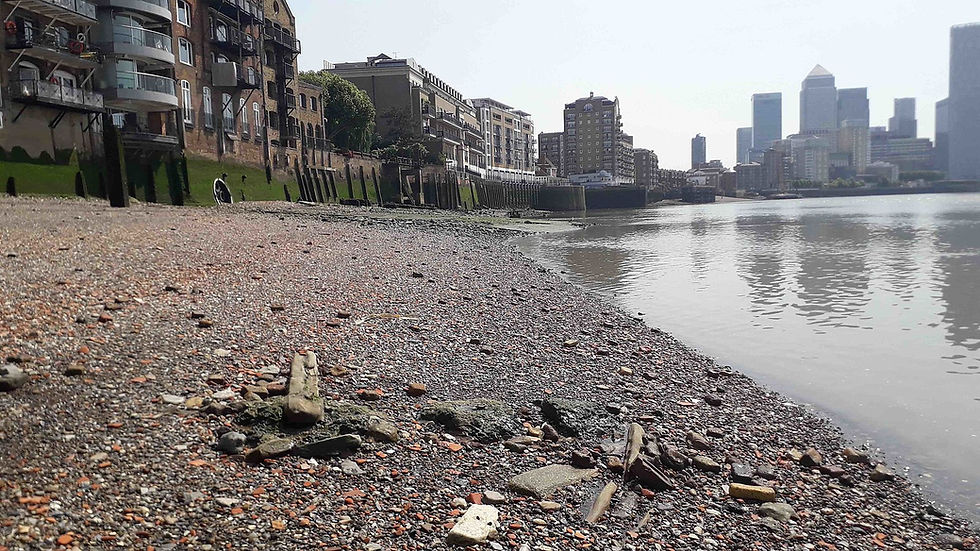Mud-larking Along the Thames
Mud-larking, defined as the act of searching the riverbed of the Thames for artefacts. Admittedly, it is a bit of a hard sell for a pastime activity.
Most of this seems owed to the rather terrible reputation that the River Thames has attracted. Unfairly so, it seems commonly cited as a labyrinth of waste, a dumping ground of sorts that spans for eleven unbroken miles. These meanderings circulate with such ferocity that the waterway is made a rather unappealing place to venture towards. Admittedly the unpalatable brownish colour of the Thames does quite little to help its cause. But for this reason, the mention of mud-larking — an activity which requires you to kneel down beside those murky waters for considerable amounts of time — arouses a weariness and unwillingness of sorts. What fool could be driven to do such a thing?
And yet, looking over the railings protecting Londoners from those unappetising waters, it seems there are many fools driven to such activities. With the help of a low tide, you can always find a mud-lark pottering about.

Hunching down in eunuch-like fashion and searching for antiquated artefacts has been a practice around for some time. Mud-larking made its debut two hundred years ago in the Victorian period. Nicknamed the ‘Foragers of the Foreshore’, mud-larking came to existence as the nifty pastime of hunting down items which could be flogged.
So what for all this rambling on this odd pastime of clambering down to the riverbank and essentially picking up antiquated litter? Is there any purpose of wading into the underbelly of London? Or is it just a rather desperate eccentricity to fill the vastness of time?
In my humble opinion, mud-larking allows us to interact with the past on an intimate level. Most artefacts found whilst mud-larking are completely and utterly ordinary (admittedly, I could just have terrible luck but for the sake of my point, let us assume not). They are tokens of everyday existence, items which were mindlessly yet frequently used by ancestral Londoners. Throughout the years, I have stumbled upon numerous clay pipes, fragments of Victorian pottery, Georgian wig curlers, and even shoes. They are items which are overwhelmingly mundane. And yet, they have taught and connected me more to history than anything else I have ever encountered.
These ordinary items are fragments of all the past lives which exist behind modern-day London: old pins once sewed onto a mother’s coat, clay pipes smoked defiantly against gusts of wind, and shoes treading down cobbled streets of Victorian London. These items allow us to imagine small vignettes of past existences. Mud-larking is about as human and personal as history gets. These artefacts advocate a way of recalling the past that splinters off from the distanced manner by which we normally acquaint ourselves with history. It is an intimate, quiet way of journeying back — a sort of paying homage to all the parts which make up London’s rich heritage.
They remind us that London was not always a haven of concrete slabs and over-priced small plates — that London as a metropolis existed in an entirely dichotomous format to its modern counterpart; a thought quite comforting to me.
It would not be an overstatement to say that mud-larking advocates an approach to history that is refreshingly different. At the risk of treading the waters of soppy sentiment, mud-larking finds virtue in the unheard and often forgotten stories of history.
It is a needed reminder that worth can be found in mundane findings — that history can be encountered from buttons and broken ceramics. History is as much nestled in our unbecoming riverbank as it is in our institutions. Most exciting is that mud-larking situates history well within our reach. It requires us to use our own volition, to walk down and find history ourselves rather than idly waiting to digest it through our various screens. Mud-larking beckons us from the side-lines — to search, chase, and dig. To actually tactilely engage with our landscapes and remind ourselves of what came before us.
As London gets overridden by the fads and trends of modernity, I would urge you to venture down to the Thames’s foreshore and do a spot of mud-larking yourselves. The riverbank is ridden with curiosities and uncovered histories. Perhaps you may find some yourselves.
Image from Wikimedia Commons

Comments